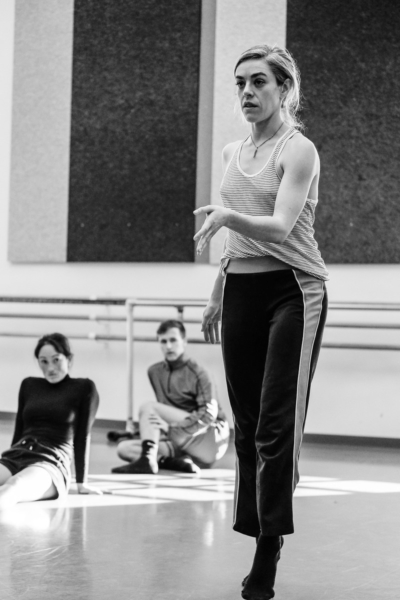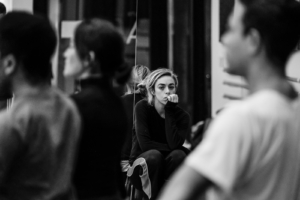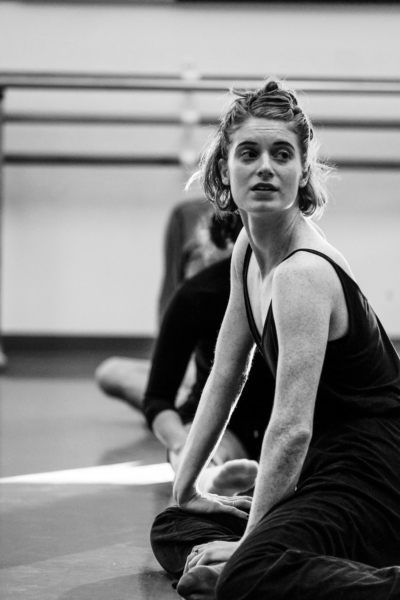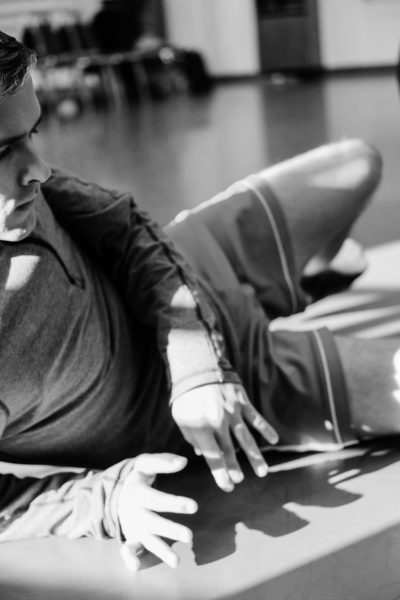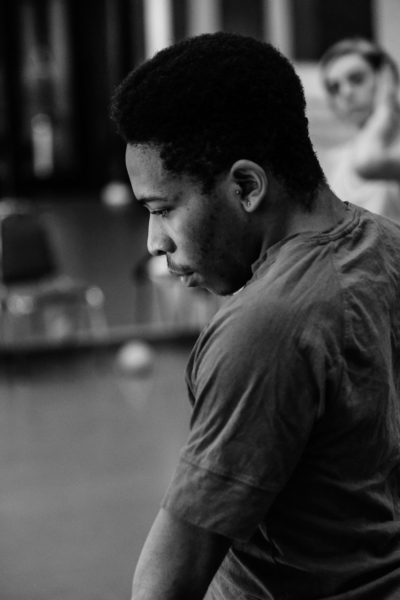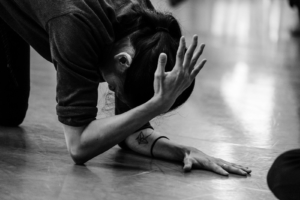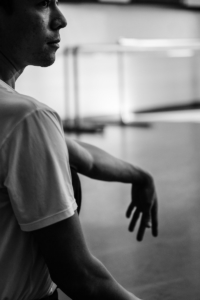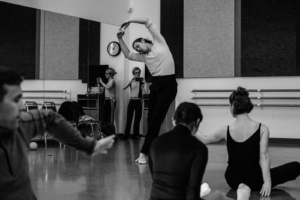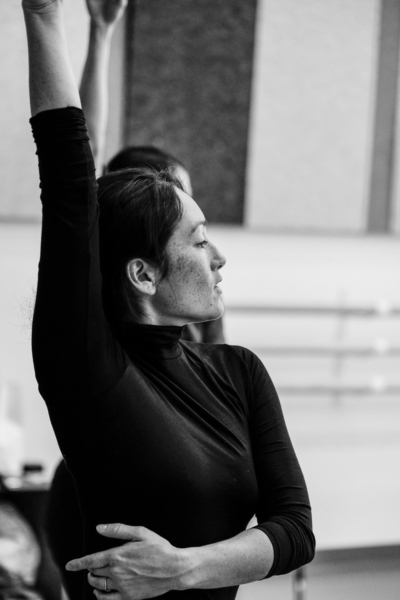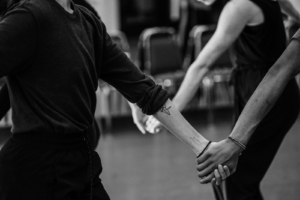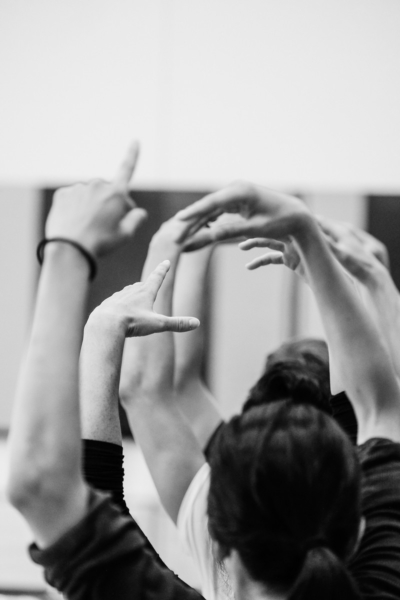“What got you dancing?” I asked Zoe Scofield, who’s creating her 1st piece for Whim W’Him‘s upcoming program, 3 x 3, opening Friday, January 18, 2019 at the Cornish Playhouse.
“My sister’s tutu,” she answered promptly. “I wanted that tutu!” So Zoe joined in ballet lessons, in Gainesville, GA where she grew up, “and it just kept going. I was always dancing around the house and making things.” She took at once to the pleasure and discipline of movement in class, and that initial delight has stayed with her ever since, becoming her passion, calling and profession, both as a dancer and a dance creator.
Zoe attended the top-ranked Walnut Hill School for the Arts in Natick, MA, near Boston, where she received a Monticello Choreography Fellowship and graduated with high honors in dance. The next couple of years were spent at the Boston Conservatory and dancing with Prometheus Dance in Boston, then with Atlas Moves in Toronto. In 2001, Zoe moved to Seattle and, though she does a lot of traveling, has remained here, garnering many commissions and awards, including a 2015 Guggenheim Fellowship.
Zoe’s ideas come from everywhere, generated by the milieu, by something she’s read or seen, people in the room. The piece she is now completing for Whim W’Him came out of “almost formalistic research,” she says. “I was looking at rhizomes, rhizomatic philosophy, things that can sprout here and there but are connected underground. What would that look like?”
Her ideas grew and changed. “What would it be like to play with the fomalism of ballet? but it’s definitely not ballet … or with almost mechanical movements? … or with folk dance? What do these worlds look like on top of one another?” In the piece, dancers, in discrete little nodules you might say, each with distinct movement and style, “influence and play off each other.”
In the studio on the first day, “We just started playing with some ideas. A lot of times I’ll have ideas and see what the dancers do with them. I give them tasks. Like conversations with them.” Ideas “grew and morphed from the physical process, and from that meaning comes,” Zoe says. “I never really know what’s going to happen.” That’s the excitement of it, and “it’s still evolving for sure.”
Of the Whim W’Him group she says, “They’re such quick, facile dancers, it’s possible to have a dynamic conversation with them,” that she can then shape. “It was really fun in that regard. We just started going for it.” A lot of material was generated, but “a bunch of sections I made and threw out. It was a great process.” And the discarded ideas won’t necessarily vanish. They might lodge and sprout up elsewhere, if not in this piece perhaps in another, like those rhizomes…
The two types of music Zoe is using make a curious and intriguing combination. “There are a couple of pieces I’ve always been interested in, and it wasn’t ever the right moment.” The pianist Glenn Gould playing Bach is very moving to her, as he hums lightly in the background of his recordings. “You hear the human hand, you feel his process of experiencing music. It’s imperfect, and that makes it more perfect. We have this idea of Bach, pristine, untouchable, only available to a few. But his is different. Where does that come into play?”
In Zoe’s new work, the group always there, in evidence even during a danced solo. She thinks about the meaning of a “a solo pianist, feeling very alone—especially in juxtaposition” to the dancers’ ensemble movement.
The other music Zoe is using is “the raw, uniquely American tradition of Sacred Harp Singing,” a form of sacred choral music sung in 4-part harmony. In this country it originated in New England, then was taken up and carried on in the South. The name does not refer to what we think of as a musical instrument, but rather to the organ-like sound of massed human voices lifted in worship. It is also the title of The Sacred Harp, a much-loved traditional book printed in shape notes, a musical notation designed to facilitate community singing.
Sacred Harp Singing has previously figured in work by Zoe and Juniper Shuey, her sculptor-lighting designer-videographer partner in their company zoe | juniper in their dazzling production, Clear & Sweet. That piece, like the current one “plays with constantly shifting points of perspective and highlights strengths in roots and community.”
Juniper, although not contributing formally to this new piece, “he has been involved on the outside. He’s watched a couple of rehearsals and given feedback. He’s very good at coming in and asking ‘What’s happening? what am I seeing?'” Juniper has been involved, too, in making the set. “It’s not a piece that has a lot of stuff. Our ideas can be a bit … resource-heavy,” Zoe remarks disarmingly, but “It’s been fun. Juniper has very interesting ideas about what movement is doing. It’s good to have him in the rehearsal space.”
Like Bach, Sacred Harp music “feels sacred and perfect on a different level and scale. Both have the weight and sacredness, but are different in accessibility. I like the play and tension there. Sacred Harp really only exists in a group. A very rhythmic part is almost in direct contrast to the time in Bach. What does that feel like, even in the audience. Does it make people experience feelings in their body they didn’t have of how it worked or fitted?”
“There is restraint, a kind of simplicity. I’m interested in what comes from that place, that’s what I’ve tried to get into in this piece. Sometimes showing up and being kind is enough. It’s a big deal.” In these difficult times, when there is so much that is noisy, outsized and melodramatic, “the quiet is huge,” a solace and a revelation.
Photo Credit: Stefano Altamura
